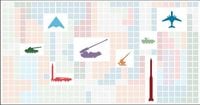On September 3, 2025, Beijing’s iconic Tiananmen Square became the stage for a spectacle that was both a commemoration and a declaration. China marked the 80th anniversary of the end of World War II with its first major military parade in six years, an event brimming with symbolism, technological bravado, and unmistakable geopolitical messaging. President Xi Jinping, standing in a black limousine, saluted wave after wave of troops as fighter jets and helicopters thundered overhead. In a dramatic flourish, twenty-six helicopters traced the number “80” above the square, a vivid reminder of Japan’s surrender in 1945 and the war’s conclusion in Asia, as reported by Reuters and BBC.
But this was more than a pageant of remembrance. Observers from around the world watched closely as China unveiled what many analysts described as its most significant military advancements in years. For the first time, the People’s Liberation Army (PLA) presented its land-, sea-, and air-based strategic forces together—a nuclear “triad” that places China in the same league as the United States and Russia in terms of global nuclear deterrence. The parade’s message was unambiguous: China is closing the technological gap with the world’s leading military powers, and it wants everyone to know.
“The bottom line is that China didn’t just roll hardware,” one defense analyst told BBC. “It rolled out a playbook—nuclear deterrence, hypersonics to deny access at sea, and unmanned systems to change the economics of war.” The parade, which lasted about ninety minutes, showcased not just the might of China’s armed forces but the direction in which its military doctrine is evolving.
Among the most striking elements was the debut of China’s full nuclear triad. According to Reuters, this included the upgraded DF-5C ballistic missile, capable of striking targets across the globe; the H-6N strategic bomber, a thoroughly modernized version of a Soviet-era design now equipped to carry nuclear weapons over long distances; and the JL-3, China’s most advanced submarine-launched ballistic missile, deployed on submarines based on Hainan Island in the South China Sea. The JL-3, in particular, is a linchpin of China’s “no first use” nuclear policy, ensuring that the country retains the ability to retaliate even if its land-based arsenal is compromised.
The parade also featured the DF-61 intercontinental ballistic missile, a new road-mobile system that Western analysts are expected to scrutinize for months to come. Its mobility makes it harder to detect and target, increasing China’s second-strike capability. Naval and air power received equal billing, with the H-6N bomber and a fleet of hypersonic anti-ship missiles—YJ-15, YJ-17, YJ-19, and YJ-20—paraded as a direct challenge to U.S. and allied naval forces in East Asia. These hypersonic weapons, tested against mock-ups of U.S. aircraft carriers, are designed to be faster and more maneuverable than traditional missiles, complicating any American response to a regional conflict, especially over Taiwan or the South China Sea.
Yet, it wasn’t just the big-ticket items that caught the world’s attention. China’s parade put a spotlight on unmanned military systems, signaling a shift toward what some analysts call “fighting with volume.” Long-range drones, underwater vehicles shaped like torpedoes, and even robotic quadrupeds rolled through the square, representing a move toward cheaper, scalable solutions that could overwhelm more expensive enemy platforms. According to BBC, new formations for aerospace, cyberspace, and information operations were also introduced, suggesting that future wars will be fought not only on land, sea, and air, but in space and across digital networks.
Laser and microwave weapons—once the stuff of science fiction—were showcased as part of China’s expanding anti-drone arsenal. The PLA demonstrated missile guns, high-energy laser systems, and high-power microwave devices designed to counter swarms of enemy drones at low cost. Laser weapons, still under development, could eventually be used to disable missiles or even satellites, while microwave systems, though technologically simpler, present deployment challenges due to their potential impact on friendly forces and equipment. State media described these as forming a “triad” of anti-drone systems, underscoring the PLA’s focus on layered, multi-domain defense.
Behind the scenes, China’s military modernization is increasingly driven by artificial intelligence. In January 2024, researchers at Shanghai Jiao Tong University published a study on using AI to deploy weapons in automated “kill webs” that adjust in real time to battlefield changes during naval combat, according to The Wall Street Journal. Just six days after the study was released, the university was awarded a defense contract to make the concept a reality—a testament to how quickly China is moving to integrate cutting-edge technology into its warfighting doctrine.
The parade was not just a technological showcase but a diplomatic statement as well. Russian President Vladimir Putin and North Korean leader Kim Jong Un stood alongside Xi Jinping, reinforcing Beijing’s alignment with Moscow and Pyongyang at a time of heightened tensions with the United States and its allies. Notably absent were leaders from the U.S., Europe, Japan, and India, a fact that did not go unnoticed by international observers. The event’s guest list underscored the shifting geopolitical alliances in the region and the world.
China’s military modernization has been a long-running project, but this year’s parade represented a leap forward in both capability and confidence. Compared to previous parades in 2015 and 2019, the 2025 event was longer and more ambitious, highlighting advances in battle management, communications systems, and the integration of various weapons platforms. As Reuters noted, the hardware on display was meticulously cataloged by analysts, who counted and cross-referenced every vehicle, missile, and drone against previous images and expert advice to gauge the true extent of China’s progress.
Foreign analysts are now left to ponder how effectively China can translate these technological gains into real-world military deterrence. The emergence of large, torpedo-like underwater drones, for example, could present new challenges to China’s naval rivals if they can be produced cheaply and deployed effectively. Questions remain about how some of these new systems will be used in practice, but the trajectory is clear: China aims to harness technology to win future wars, not just match its adversaries but potentially outpace them.
As the dust settled on Tiananmen Square, the strategic implications of the parade lingered. While military parades are not battlefields, they are powerful signals. This year, China’s message was unmistakable: the era of uncontested American military dominance in the Asia-Pacific is drawing to a close, and a new, more technologically sophisticated competitor is on the rise.




